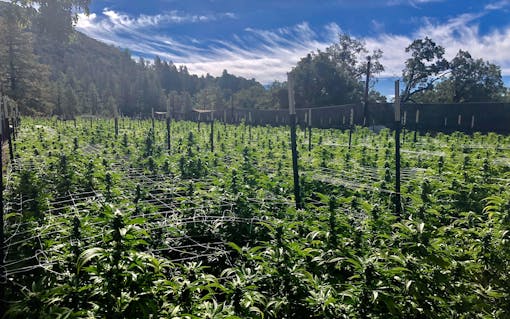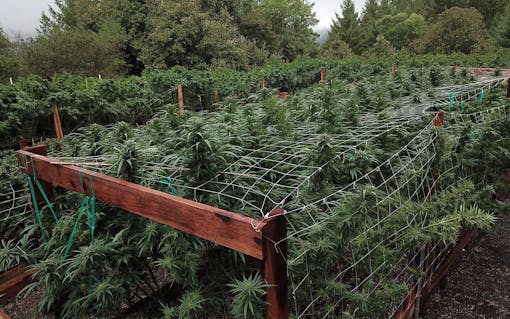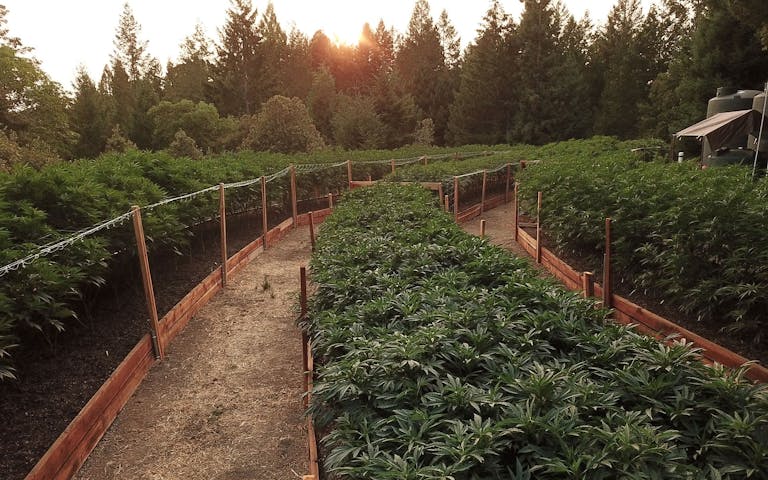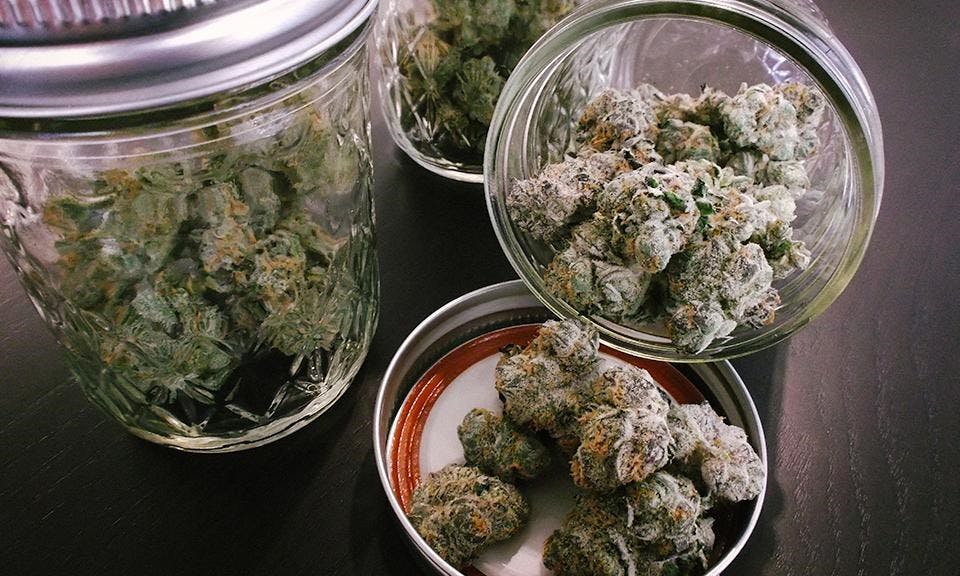Twelve hundred feet above sea level, 50 miles from the Pacific Ocean, behind the longest continuous mountain ridge in the US, Flowerdaze Farms’ buds bake in the October sun.
Staples like Key Lime Pie, Strawberry Cough, and Infinite Euphoria give off waves of aroma so thick you can nearly bite into them. Jacob Johnson, 32, the award-winning biodynamic farmer who oversees production here, breaks into a smile just talking about it.
“The resin production is especially phenomenal,” he said. “Everything is so frosty and the little trichomes are all engorged. This year, everything is super sticky and fragrant.”
Destined for stores in San Francisco, Sebastopol, and San Diego, Flowerdaze joins a historic bumper crop of outdoor-grown, full-season cannabis coming in from the fields across North America this fall.

Powerhouse varietals like Purple Punch, Sunset Sherbert, Red Dragon, Do-Si-Dos, and Gorilla Glue will come to market by Christmas. Prices on the illegal market could stay near historic lows of $400-$500 per pound amid the market glut. That translates into about $50 per retail ounce.
This year’s superb harvest quality is good news for farmers, but it hasn’t decreased their stress level much. No season in history may prove as taxing as 2018 in Northern California, where price collapse plus the paperwork hassles of legalization triggered what some have called “extinction events.” The core growing region of the Emerald Triangle—Humboldt, Mendocino and Trinity counties—is reportedly experiencing “economic collapse.” According to some reports:
- Local hydroponics stores sales fell 70% this year in Mendocino County.
- Vacant business space runs block-wide in Garberville, CA.
- Humboldt County might have 30 times the average property listings, as folks dump homes.
“It’s so dramatic,” said Kym Kemp, an industry expert in southern Humboldt County. “Farmers I know are quitting, selling, and moving.”

Price Hits Rock Bottom
The end of cannabis prohibition promised extreme turbulence for the communities that profited from the old system. That turbulence has finally arrived.
Americans consume an estimated 6,000 metric tons of the crop across legal and illegal markets each year, most of it from Mexico. But California remains the nation’s number one domestic producer, and the Triangle is number one in California—good for an output of 1.7 million pounds per year.
Eighty years of cannabis prohibition warped the economy in the tri-county region. Natural market prices were inflated tenfold. Prohibition drove a need for secrecy that kept farms small and pushed cultivation into wildlands too remote to raid.
Prohibition prices peaked at more than $5,000 per pound in the late ’90s and early 2000s. Market normalization—prices are now in the $500-$1,500-per-pound range—can feel like economic calamity.
Today, nine states and Washington, DC, have legalized the adult use of cannabis. More than 30 states allow the legal use of medical marijuana. As prohibition’s risk recedes, so do the costs of growing legal cannabis.
Find Legal Cannabis Near You With Leafly Finder

Swami Select Farms (David Downs/Leafly)
Regulations Pile On
The wholesale price of cannabis has been sliding for years. What made this year different was the mountain of red tape and a decision point for every farmer: Go legal, burrow further underground, or get out of the business entirely.
The permit process never seemed to end.
Farmers didn’t farm this year—they spent their days doing paperwork, said Stephen Dillon, founder of True Humboldt, in Humboldt County. Dillon went through the legalization process, and he’s dealt with Humboldt County, the state Bureau of Cannabis Control, Department of Fish and Wildlife, the Water Board, OSHA, unions, ADA compliance, workers’ comp, and so on, he told Leafly.
“The permit process never seemed to end,” he said. “It’s been harder than writing a thesis paper to finish college.”
“We went from zero regulations to something that’s federally illegal and being tightly regulated,” said Mark Shaffer, owner of Shelby Ridge Farms in Comptche, CA.
“I’m not surprised we’re getting hit over the head with this,” he said. As a former environmental consult for laundromat companies, Shaffer said, he had a bit of an experience edge. “That’s part of the advantage I have right now—I know how to fill out government paperwork. This is how bureaucracies come at you.”
By some estimates, three quarters of California growers who started filling out state and local applications might not have finished them this year. Just a third of the growers on Dillon’s road are active.
“I know for a fact people are just totally overwhelmed,” Dillon said. “We’re seeing a lot of people not make it, and that’s really sad.”
Local officials now use satellite data to track compliance in the backwoods. Humboldt County capped farm canopy size at 2015 levels, and sent out 600 to 800 abatement letters this year to suspected violators. Penalties can include fines of $10,000 per day.
Find Legal Cannabis Near You With Leafly Finder

Sunscreen of Green: Elongated cannabis flower beds stretch more than 200 feet. (Courtesy Shelby Ridge Farms)
Production Might Have Peaked
After years of doubling crop sizes and doubling again as prices tumbled, farm sizes seemed to have peaked across the Triangle. There’s too little profit to keep going.
In Northern Humboldt, “I know people who know PG&E helicopter pilots flying the county all summer,” Dillon said. “They’re seeing about 30-40% of farms out there not planted this year.”
In Mendocino, Shaffer estimated that 20% of farmers got wiped out by last year’s crop prices and lack the capital to keep going.
“I think definitely a lot of people scaled back this year,” Johnson reported from the heart of the Triangle.
“We probably have started to peak and will drop back,” said Kemp, from Southern Humboldt.
Questions About Adequate Legal Supply
There seems to be plenty of cannabis sloshing around America. Californians can grow six plants per property—yielding perhaps a six-year supply for one person.
The most common price for pot is already free, RAND researchers found in the book Marijuana Legalization: What Everyone Needs to Know. Most transactions are gifts.
As for the legal recreational market in California, no one knows if there is enough supply for a fully mature market. There are few fully permitted farms in California, but there are only 350 or so licensed retailers as well. Much of the California-grown crop that remains in state remains in the illicit market.
A limited supply of licensed pot may prove adequate for the few stores this year.
It’s hard to know exactly what’s happening. “I’ve heard there’s a glut and I’ve heard there’s a shortage,” said Johnson.
“I do think the supply this year is going to be semi-restricted, and not as big as people think,” Dillon said.
“I don’t think that we’re going to know,” said Christina DiPaci, an official with The Weed Brand in Salinas Valley, California.
One early signal: the price for clean trim—leafy plant leftovers used to make oil for infused edibles—are way up. Bidding wars broke out on Humboldt County radio this summer for trim—up from $25 a pound on the illicit market to $250 a pound today, Dillon said.
“We have a line out the door for trim,” said DiPaci.
Shimmers of Hope Everywhere
Even with some declaring the Emerald Triangle a Grapes of Wrath 2.0, hope continues to shine through. A supply chain has reconstituted itself on the legal side. Reports of fair prices buoy spirits. Local regulators began listening to farmers, and revising fees and rules.
The Triangle sits at crossroads. Cannabis could become a commodity like corn in Iowa, or it could provide the basis for a global brand like Champagne from the Champagne region of France.
Local bud has character—with more a diverse look, aroma, and effect. They call it “terroir,” borrowing language from wine.
“There is a possibility we are going to survive this,” said Kemp. “I feel a tinge of awkward hope.”
She thinks “the consumer is going to be very excited by the flavors and smells of this season.”
Market collapse has “happened to small farmers many times in the past and all over the world,” said Johnson. “We shouldn’t feel alone in this fight. We can have a positive reaction to it, rather than just suffering our fate.”
“We still see through to the other side—this bright future,” Dillon said. “It’s a matter of getting through this turbulent time, but we feel good about it.”
Photos courtesy of Shelby Ridge Farms and Seed707 Farms.







